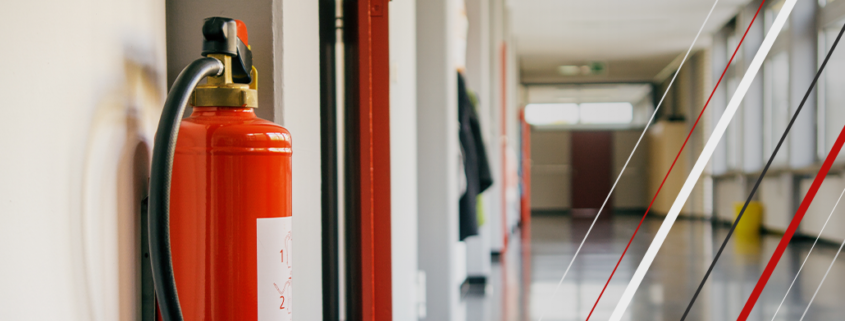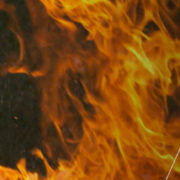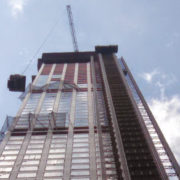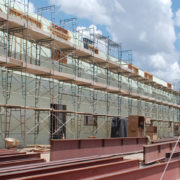The principal method of fire stopping and damage limitation is achieved through compartmentalising a building. This involves the installation of fire-resistant walls, floors and ceilings.
In the last 10 years the UK has seen a 37% reduction in fires that require the assistance of the fire service. This has also resulted in a 27% drop in the number of casualties. The decrease can be partly be attributed to the advancement of fire protection methods that stall the spread of fires to enable the safe evacuation of occupants to the building, provide an early alert and prevent ignition. Despite these positive number, 68,871 serious fires were recorded in 2019 meaning that there are still improvements to be made in fire safety to protect and preserve life.
Construction companies have an obligation to incorporate fire safety into the design and construction of buildings. So, what requirements need to be met, how is the risk evaluated and which protection methods should be installed?
Fire Protection and the Law
The Regulatory Reform (Fire Safety) Order 2005 applies to every building used for the public and as workplace. The law states that a designated responsible person with a level of control over the building must take reasonable steps to reduce the risk of fire and to ensure safe evacuation of all people occupying the building should a fire break out. Part B of the Building Regulations covers residential dwellings through several requirements such as the use of adequate fire warnings and escapes, the installation of passive fire protections to stop the spread of external and internal fire and the presence of access for fire services. Compliance of these regulations is the very minimum to ensure fire safety in buildings and also applies to the health and safety requirements during the construction of the building.
Risk Assessing
Before applying fire protection strategies to any building, the risks must be identified. A full fire risk assessment must be carried out at the design phase. It should then be repeated during construction to ensure fire safety measures are being included and then again before the building is handed over to the client. The final assessment demonstrates compliance and aids the building owners in enforcing fire protection once they become responsible.
A fire safety risk assessment should include:
- Fire risks including potential ignition points, flammable materials or areas that could fuel or help spread a fire.
- What risk it poses to people. It must include any vulnerabilities people have that would inhibit their safe evacuation from a fire, lone workers or groups of people working with combustible materials.
- The solutions put in place to minimise the risk.
- A plan for emergencies such as escape routes and access for fire services.
- A review and checking procedure to ensure that fire safety is a high consideration.
Active and Passive Fire Protection
Once the fire risk assessment is complete and hazards have been mitigated, plans should be made to minimise the impact of any remaining risks. To do this, active and passive fire protection systems need to be in place. Both of these measures provide the building with measures to fight a fire and prevent it from spreading. Architects and contractors must work together to implement these measures into the design of a building and maintain them to deliver continued protection.
Active Fire Protection
Active fire protection is the term given to fire safety measures taken to fight fires after they have started. They are a powerful and essential line of defence for all buildings. Active systems include sprinklers, fire extinguishers and automatic dousing systems. Designers should consider each system to the building using water, foam, powders or gases to stop a fire in the quickest and safest way.
Alarm systems are also a powerful fire protection tool that are imperative to the fire safety of a building. Fire alarms alert occupants immediately to a threat which means action can be taken quickly.
Passive Fire Protection
Passive fire protection is imperative to preventing the spread of a fire. Passive measures resist the fire, compartmentalise its impact, protect the structural integrity of the building and provide vital time for people to evacuate. They are referred to as passive measures because they require no action in order to work.
Passive measures are usually installed in the structure of the building. They are built into walls, ceilings and floors and provide the following benefits:
- Structural support
- Heat insulation
- Reduction of the spread of gas and smoke
Passive fire protection plans require a range of measures to work together to provide the best defence.
Common passive fire protection installations include fire doors, partition glazing, cavity barriers and gap seals. Passive measures can also be found in the foundations of buildings in the form of concrete, bricks and gypsum plasterboard. This is also used to protect structural stability of the building and compartmentalises fires. Some measures can offer up to four hours of protection allowing time for firefighters to arrive and tackle the blaze.
Dampening is another important passive fire protection tool. Ducts, pipes and cables provide hidden passage for fire and smoke to spread which is usually gone unnoticed. It is essential to include fire and smoke dampeners when installing heating, ventilation and air conditioning units. Proper maintenance of these installations is needed for the measures to be effective.
Planning Evacuation
A key part of a fire protection plan is to design a safe evacuation route. All occupants of the building must be able to leave quickly and safely in the event of a fire. Alternatively, architects should design fire-proof areas for those that aren’t able to evacuate. These spaces are designed to protect people until the fire service arrive. When planning an escape route, maximum capacity of the building, consideration of the mobility needs of the building users and access for firefighters are essential.









Leave a Reply
Want to join the discussion?Feel free to contribute!